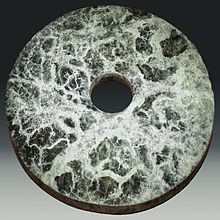Liangzhu culture
The Liangzhu culture ( Chinese 良渚 文化 , Pinyin liángzhǔ wénhuà ) is a culture of the late Neolithic on the southeast coast of China .
In the 1970s and 1980s archaeologists discovered late Neolithic tombs in the Tai Lake area in the lower Yangtze Valley in China. They date from the time between 3400 and 2000 BC. More than 5000 pieces of jade, including perforated discs and tubes, were found in these graves . These are said to have been ritual objects given by the king. Their use was related to the worship of heaven and earth.
Most of the jade stones are made of nephrite . They depict creatures that, since it is believed that the use of metal was still alien, in all probability were carved with shark teeth. The excavations show the great importance that jade had in this region at that time. From the text Zhouli (The Rites of the Zhou), which was published between 400 and 300 BC. It can be inferred that these jade objects were still used during the Zhou dynasty (1000–221 BC).
Significant sites of Liangzhu culture are Liangzhu Site , Fanshan Site , Yaoshan Site , Yuhang Site , Sidun Site , Mojiaoshan Site, and Huiguanshan Site .
The oldest evidence of large hydraulic engineering systems in China comes from this culture . An approximately 5,100-year-old system of dams, canals and water reservoirs was discovered that made it possible to irrigate 10,000 hectares of agricultural land.
See also
Web links
- Jerrod Roalstad: Liangzhu Culture. (No longer available online.) In: mnsu.edu. Minnesota State University, archived from the original on July 24, 2010 ; accessed on January 23, 2014 (English).
- Riddle of Liangzhu Culture expected to be solved. In: en.people.cn. People's Daily Online, July 4, 2004.
Individual evidence
- ↑ Yang Xiaoneng: New Perspectives on China's Past. Chinese Archeology in the Twentieth Century. Yale University Press, New Haven 2004, Vol. 2, pp. 90–90.
- ↑ K. Kris Hirst: Liangzhu Culture. (No longer available online.) In: archeology.about.com. The New York Times Company , archived from the original on June 28, 2008 ; accessed on December 29, 2018 (English).
- ↑ (tasch): Huge hydraulic engineering system from ancient China discovered. In: The Standard . December 9, 2017. Retrieved December 9, 2017 .
